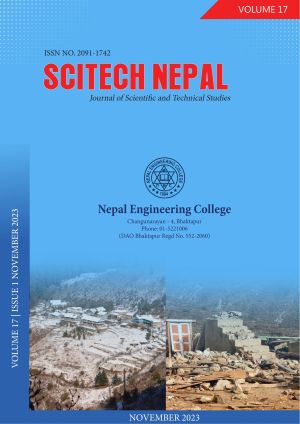Barriers to Implementing Safety Measures During COVID-19 Pandemic on Building Construction Projects in Nepal
DOI:
https://doi.org/10.3126/scitech.v17i1.60494Keywords:
Building construction projects, COVID-19 pandemic, Principal component analysis, Safety barriers, Safety measuresAbstract
The COVID-19 pandemic caused disruptions in building construction projects, with safety measures being a major concern for workers and the public. This study aims to assess the barriers to safety measures during the COVID-19 pandemic on building construction projects in Nepal. A total of 330 responses were collected from construction professionals in Nepal using a Likert scale. To ensure the data's suitability for factor analysis using Principal Component Analysis, Kaiser-Meyer-Olkin, Bartlett's Sphericity test, inter-component correlations, and Cronbach alpha scores for internal consistency were checked, and principal components were extracted. A 25-item safety barrier to safety measures in building construction projects during the COVID-19 pandemic was identified through an extensive review of the literature; six components were retained using Principal Component Analysis which represented the model of choice and explained 62.86 % of the data variance. The components were; inappropriate safety guidelines, psychological working pressure, inadequate hygiene monitoring and control, lack of safety awareness, improper working culture, and insufficient planning and scheduling. The internal consistency for the retained components was high; Cronbach α scores ranged from 0.72 to 0.796. “Inappropriate Safety Guidelines” was the most critical barrier to implementing safety measures during the COVID-19 pandemic in building construction projects, according to the rankings of the six identified components. It is recommended that construction professionals and regulatory bodies prioritize the development and adherence to robust safety protocols tailored to pandemic conditions. Regularly updating and reinforcing these guidelines will be crucial in safeguarding the health and well-being of workers while ensuring project continuity. Additionally, investing in thorough training and awareness programs can significantly mitigate this barrier's impact.




